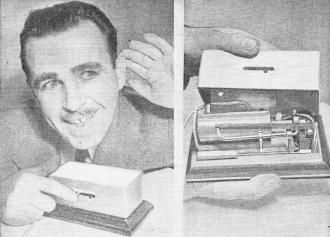|
May 1946 Radio-Craft
 [Table of Contents] [Table of Contents]
Wax nostalgic about and learn from the history of early electronics.
See articles from Radio-Craft,
published 1929 - 1953. All copyrights are hereby acknowledged.
|
"Plug-Ugly Eliminator" could
refer to a couple possible devices. One might be some sort of cover for hiding
electrical cords and plugs where the go into a wall socket. It might also be a
move decorative type plug than the standard kind on the end of a line cord. What
the Plug-Ugly Eliminator actually is, is an overly complex contraption allowing
a radio listener to turn off a radio for a predetermined amount of time when
"commercial announcements in which he may have no interest or which may even be
offensive to him" begins playing. The "Plug" part of the name is another name
for a commercial. Maurice Kay's Plug-Ugly Eliminator, which appeared in the May
1946 issue of Radio-Craft magazine, is another items where if had
occurred in an April edition, you might think you were being pranked for April
Fools. The drawing certainly has the characteristicss of a
Rube
Goldberg creation.
Plug-Ugly Eliminator

Working diagram of the apparatus which is claimed to be radio's
greatest improvement.
By Maurice A. Kay
The object of the invention is to provide a means by which a person listening
to the radio can be relieved of listening to commercial announcements in which he
may have no interest or which may even be offensive to him.
It operates by the listener pressing a button whenever the announcer begins his
commercial. This shuts off the current to the set and eliminates the commercial.
After a predetermined time interval, the current is automatically turned on without
effort by the listener and the broadcast is resumed.
Many persons turn off their radios whenever a commercial announcement comes on.
Especially those obnoxious ones - babies crying, whistles and fog horns blowing,
etc., etc. Often the person either forgets to turn the radio on again or turns it
on while the announcer is still proclaiming.
To perform the operation described above, I use an apparatus consisting of a
baseboard which supports a case in the top of which is located a switch. The switch
has a stem which when pressed closes an electrical circuit. The switch is so constructed
that it is open unless restrained by pressure on the stem.

Block diagram of the commercial eliminator.

The inventor shows how the eliminator operates (left). Inside
view of the device (right).
Mounted on the baseboard is a cylinder adapted to receive a pump piston which
slides horizontally therein. The piston has a rod which projects through a cover
in the cylinder. A spring tends to force the piston forward so that the upper end
of the piston rod strikes against the stem of the switch and closes the circuit.
Normally the spring holds the switch closed by pressing on the stem of the switch
through the piston and the piston rod.
A regulating valve is provided at the bottom of the cylinder regulating the flow
of air to the space inside the cylinder. By screwing this valve in or out, the rate
at which the air can enter the cylinder may be regulated.
Secured to and moving with the piston rod is a bent arm, one end of which is
attached to the piston rod. The other projects through a slot in the case. This
slot has a notch formed therein. This bent arm has at the end a finger button and
a pointer which registers on a scale.
When the listener hears the announcer start a commercial, he simply presses the
finger button. The bent arm to which the finger button is attached pulls down the
piston rod, causing the switch to open and abate the nuisance. As the piston is
forced downward, the air is forced outward through the valve and around the sides
of the piston. When the button is released, the spring forces the piston back. This
motion creates a vacuum below the piston which resists further movement until sufficient
air enters the cylinder through the valve and partially balances the pressure on
both sides of the piston. The piston rod continues its travel until the upper end
closes the switch after an interval of, say, 45 seconds after the button is pressed
by the listener. The listener may regulate the length of the interval by adjusting
the valve. He can, without adjusting the valve, regulate the length of the interval
by varying the distance he pushes the button down, being guided by the calibrations
on the scale. The listener can turn off the set permanently by placing the finger
button within the niche on the slot.
The apparatus if small and portable. By using wires of sufficient length, the
apparatus may be placed by the listener in any convenient location without moving
the receiver, or the apparatus my be made an integral part of the radio receiver.
The device is connected to the radio by means of a "series" plug fixed to the
terminals of the wires leading to the commercial eliminator. This series plug fits
into the electric wall outlet near the radio. The plug from the radio is then fitted
into the series plug. Thus the current to the radio is controlled through the switch
in the eliminator. When the eliminator is not operated the current is controlled
by the switch on the radio itself as in normal operation.
Posted May 12, 2021
|












